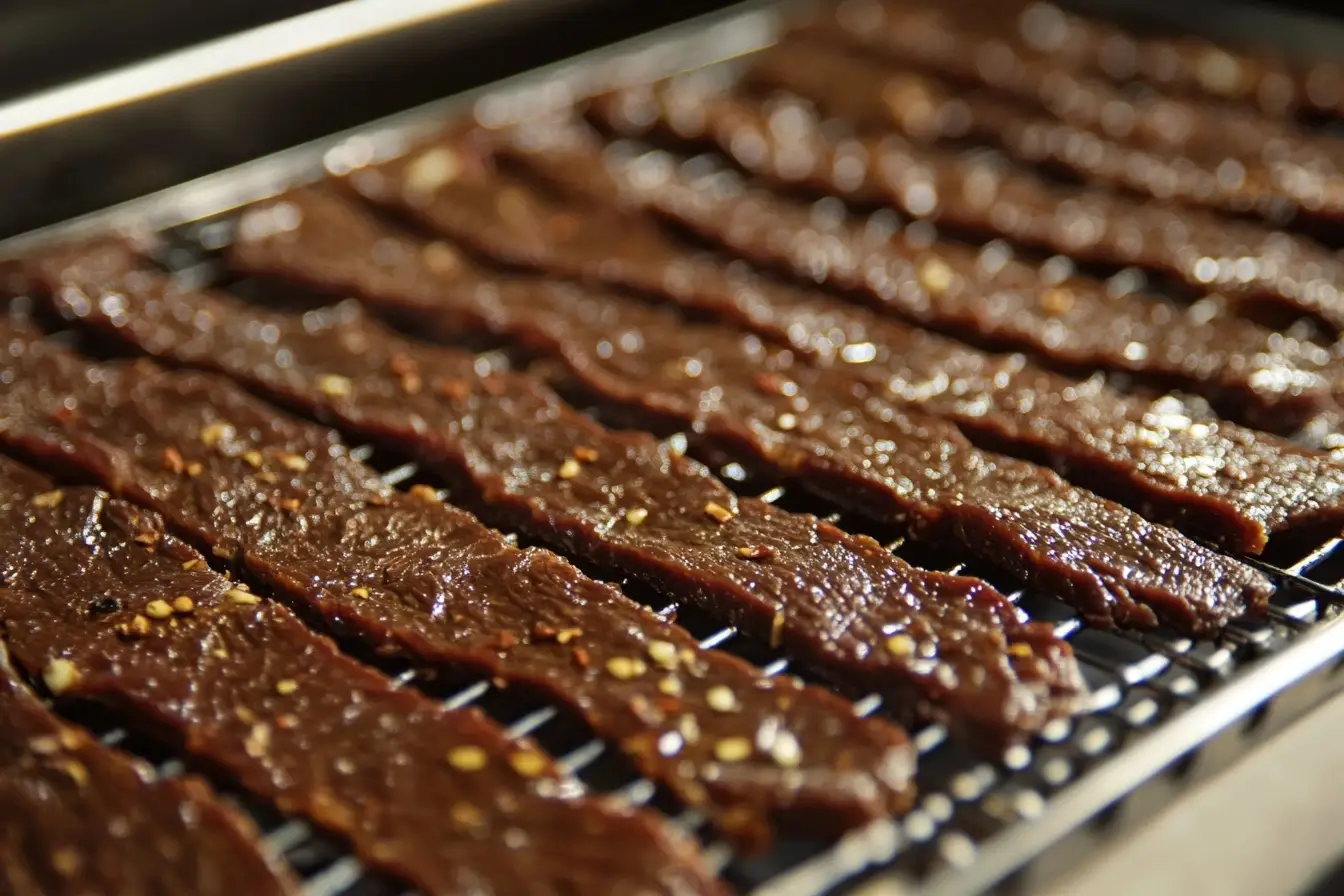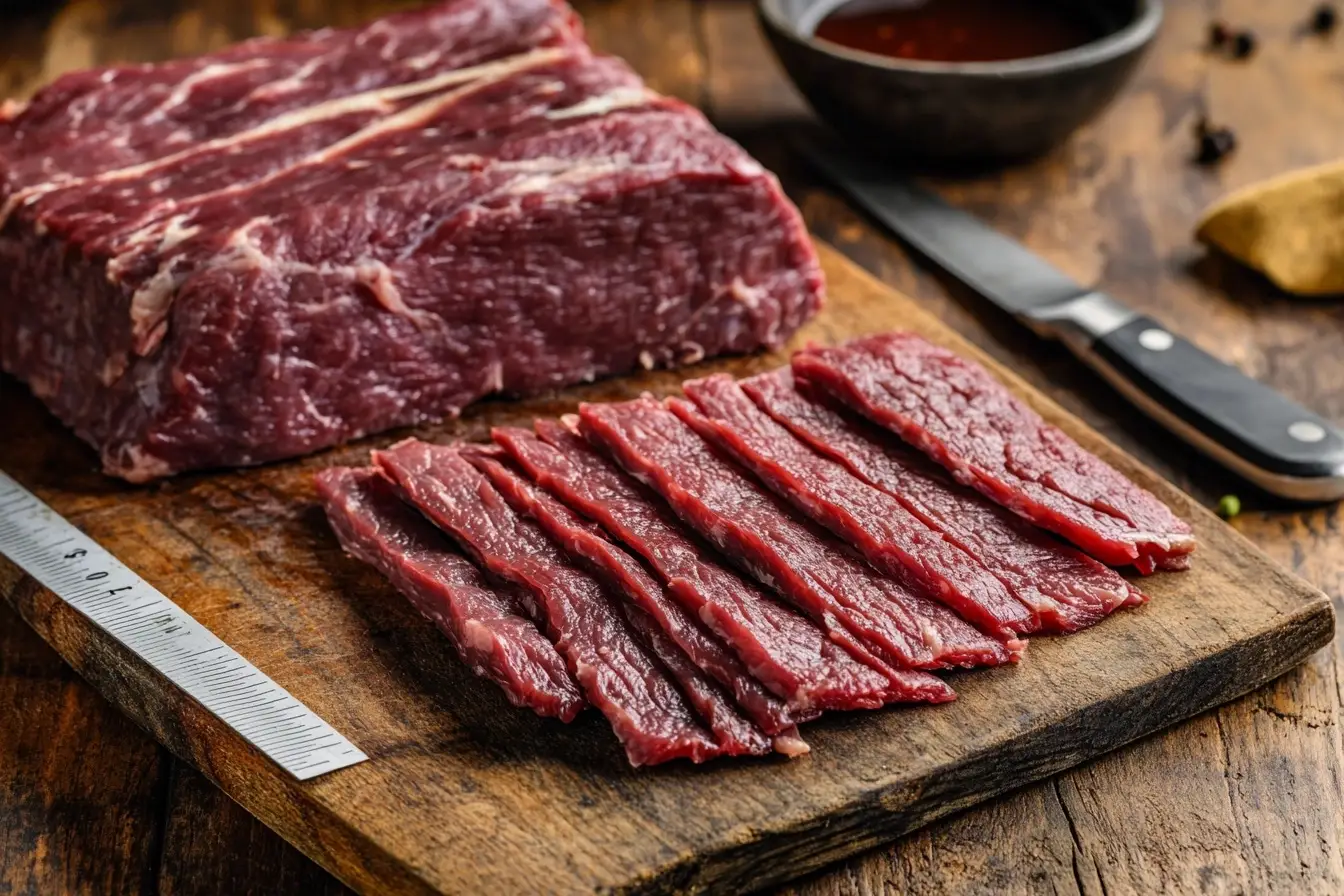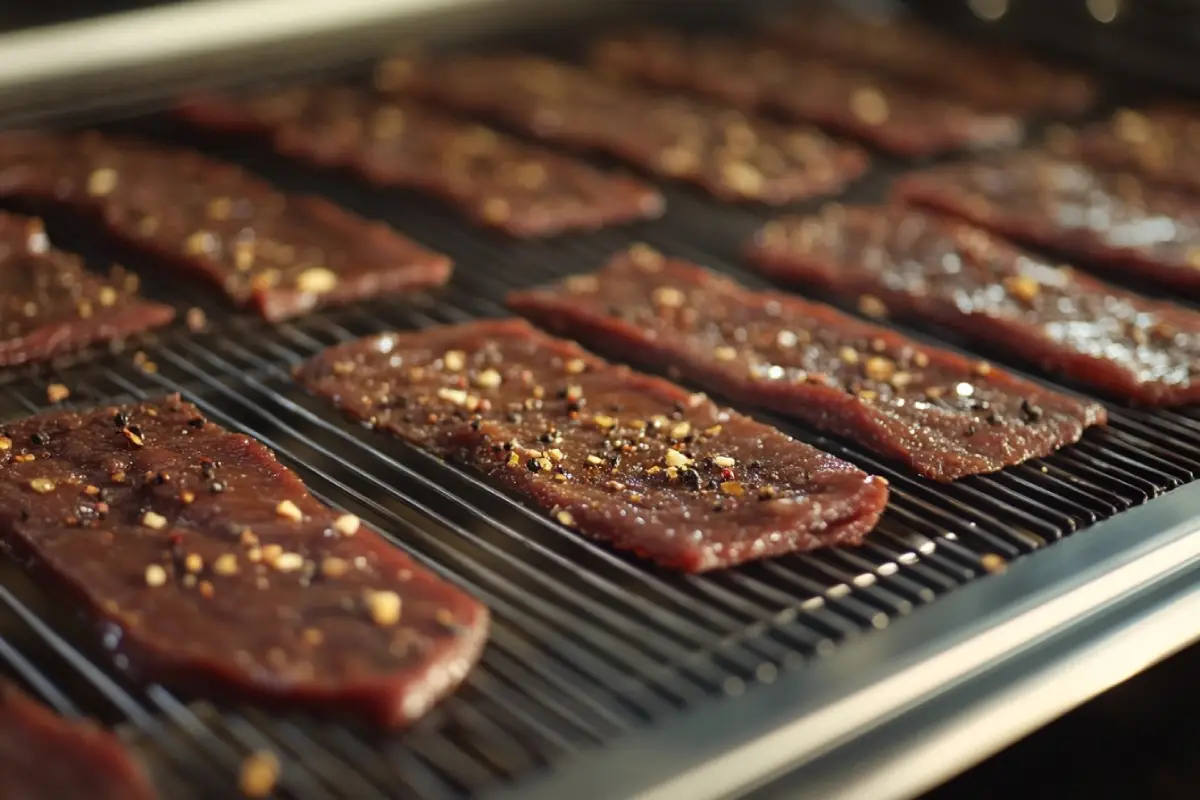Dehydrating beef jerky at home is a fun way to make a tasty snack. But, how long it takes can change based on a few things. We’ll look at the best beef jerky dehydration time and share tips for the perfect snack.
Key Takeaways
- The time it takes to dehydrate beef jerky can range from 4 to 8 hours, depending on various factors.
- Proper preparation and monitoring of the dehydration process are crucial for achieving the desired texture and flavor.
- Understanding the impact of meat thickness and dehydrator type on drying time can help you optimize the process.
- Regularly checking the jerky for doneness and adjusting the dehydration time accordingly is essential.
- Proper storage of the dehydrated beef jerky is important to maintain its quality and shelf life.
Understanding the Art of Dehydrating Beef Jerky
Beef jerky is a favorite snack in many cultures for centuries. It’s dried, cured, and seasoned, making it full of flavor. Learning about beef jerky opens up new ways to cook and eat, from making your own flavors to healthier snack options.
What is Beef Jerky?
Beef jerky is a dried meat snack from lean beef. It loses up to 60% of its moisture, becoming chewy and flavorful. This method has been used for ages, making beef easy to carry and eat.
Benefits of Homemade Beef Jerky
- Control over ingredients: Making your own beef jerky lets you pick the meat, seasonings, and marinades. You know exactly what’s in your snack.
- Customized flavors: Homemade beef jerky lets you try different spices, herbs, and marinades. You can make flavors that you love.
- Healthier alternative: Dehydrated meat snacks like homemade beef jerky are better than store-bought ones. They have fewer preservatives, nitrates, and sodium.

“Homemade beef jerky allows you to control the ingredients and create a healthier snack that’s tailored to your taste buds.”
Factors Affecting Dehydration Time
The time it takes to dehydrate beef jerky can vary a lot. This depends on several key factors. Knowing these can help you make jerky that’s just right in texture and taste.
Thickness of the Meat Slices
The thickness of meat slices is a big factor. Thinner slices dry faster than thicker ones. It’s best to aim for slices that are 1/4 to 1/2 inch thick.
Slices that are too thick take longer to dry. On the other hand, slices that are too thin can get too dry and leathery.
Type of Dehydrator Used
The dehydrator you use also affects drying time. Different dehydrators have different airflow, temperature control, and efficiency. High-quality dehydrators made for jerky usually work best, drying faster and more evenly.
Older or less powerful dehydrators might not dry the meat as well or as fast.
| Factor | Impact on Dehydration Time |
|---|---|
| Meat Slice Thickness | Thinner slices dehydrate faster than thicker pieces |
| Type of Dehydrator | High-quality, jerky-specific dehydrators provide faster, more even drying |
By understanding these key factors, you can adjust your preparation and equipment. This way, you can make jerky that’s perfect every time.

Preparing the Beef for Dehydration
Before you start dehydrating beef to make tasty beef jerky, you need to prepare the meat right. This step is key for even drying and great flavor. Let’s look at how to get the beef ready for this tasty journey.
First, remove any extra fat from the beef. Fat can mess up the drying process, making the jerky uneven and possibly bad over time. Slice the beef into thin, even strips, about 1/4 to 1/2 inch thick. This thickness helps the jerky dry evenly, making it perfect to eat.
- Trim excess fat from the beef
- Slice the beef into thin, even strips (1/4 to 1/2 inch thick)
After prepping the beef, you can marinate or season it as you like. This step boosts the flavor and makes the meat tender. Many marinades mix soy sauce, Worcestershire sauce, brown sugar, garlic, and spices. Let the seasoned beef rest for at least 30 minutes, or up to 24 hours, to soak in the flavors.
| Marinade Ingredient | Purpose |
|---|---|
| Soy sauce | Enhances savory flavor |
| Worcestershire sauce | Adds depth and complexity |
| Brown sugar | Balances the savory notes |
| Garlic | Provides an aromatic kick |
| Spices (e.g., black pepper, chili powder) | Introduces desired heat and flavor profiles |
By following these steps, you’ll be on your way to making delicious homemade beef jerky. It’s sure to satisfy your cravings.
How long does it take to dehydrate beef jerky?
Dehydrating beef jerky needs patience and careful attention. The average time to dry jerky can be anywhere from 4 hours to 12 hours. This depends on several factors.
Most home dehydrators can dry beef jerky in 6-8 hours. This gets the jerky to the right texture and moisture. But, the time can change based on meat thickness, dehydrator type, and desired dryness.
| Meat Thickness | Dehydration Time |
|---|---|
| Thin Slices (1/4 inch) | 3-5 hours |
| Thick Slices (1/2 inch) | 7-10 hours |
It’s crucial to watch the dehydration process closely. Adjust the time as needed to get the jerky right. You want it firm but still pliable, with no moisture left. With practice, you can make tasty homemade beef jerky at home.
“The key to perfectly dehydrated beef jerky is finding the right balance between food safety and flavor.”
Monitoring the Dehydration Process
Making perfect beef jerky means watching it closely as it dries. It’s key to notice when it’s done right. Knowing when the jerky is fully dry helps you get the right texture and moisture.
Signs of Properly Dehydrated Jerky
Look for a leathery, pliable consistency and the ability to bend the meat without it breaking. As it dries, the jerky should feel firm but still bend a bit. This shows it’s dried just right.
Check your jerky often while it’s drying. Bend a piece to see if it’s flexible. If it breaks, it’s not dry enough. If it’s too dry and hard, it’s overdone. You want it to feel slightly tacky, leather-like, showing it’s fully dehydrated.
“The key to perfectly dehydrated beef jerky is patience and close monitoring. Regularly check the texture to ensure you achieve the ideal balance of moisture and firmness.”
Knowing when meat is properly dried lets you adjust the dehydrator settings. This careful attention ensures your jerky is always high-quality and flavorful.
Storing Dehydrated Beef Jerky
After dehydrating your beef jerky, it’s important to store it right. This keeps it fresh and tasty for a long time. Use airtight containers or vacuum-seal it to keep the jerky’s texture and flavor.
Airtight Containers for Beef Jerky Storage
Storing how to store beef jerky after dehydration in an airtight container is a great idea. It stops the jerky from drying out and keeps it fresh. You can pick from many airtight containers, like:
- Mason jars with tight-fitting lids
- Resealable plastic bags or zipper-lock bags
- Airtight food storage containers
Vacuum Sealing for Longer Shelf Life
Vacuum sealing your dehydrated beef jerky is another smart choice. It removes air, creating a tight seal. This keeps the jerky fresh for months in a cool, dry spot.
| Storage Method | Approximate Shelf Life |
|---|---|
| Airtight Container | 2-3 weeks |
| Vacuum Sealed | 2-3 months |
Choose your storage method wisely. Keep your jerky in a cool, dry place, away from sunlight or heat. This way, you can enjoy your homemade jerky for a long time.
“Proper storage is key to enjoying the full flavor and texture of your homemade beef jerky for weeks or even months after dehydration.”
Flavor Variations and Marinades
Beef jerky lovers can try many flavors, from classic to unique. Marinading the meat before drying adds a lot of taste and smell.
Popular Marinade Recipes
Here are some top marinade recipes for beef jerky flavor profiles:
- Teriyaki: Soy sauce, brown sugar, garlic, and ginger make a sweet and savory mix for homemade jerky marinade recipes.
- Honey Garlic: Honey, garlic, and a bit of vinegar or Worcestershire sauce make a sweet and strong marinade.
- Spicy Chipotle: Chipotle peppers in adobo sauce, mixed with spices, give a bold and spicy unique jerky seasoning taste.
| Marinade Recipe | Key Ingredients | Flavor Profile |
|---|---|---|
| Teriyaki | Soy sauce, brown sugar, garlic, ginger | Sweet and savory |
| Honey Garlic | Honey, garlic, vinegar or Worcestershire | Sweet and pungent |
| Spicy Chipotle | Chipotle peppers in adobo, spices | Bold and fiery |
Trying out different beef jerky flavor profiles, homemade jerky marinade recipes, and unique jerky seasoning ideas is fun. It’s all about making tasty homemade beef jerky.
Safety Precautions for Dehydrating Meat
When making homemade beef jerky, food safety is key. It’s important to prevent harmful bacteria growth. Follow these steps for safe jerky drying at home.
Start with fresh, high-quality meat. Don’t use meat that’s old or has been at room temperature for too long. Clean your work areas, tools, and dehydrator trays well to avoid contamination.
Keep your dehydrator at 155°F to 165°F. This temperature is crucial for food safety for homemade beef jerky. It kills bacteria and keeps the meat tasty. Check the temperature often and adjust it to dry the jerky evenly.
- Cut the meat into thin strips, no thicker than 1/4 inch. This helps it dry evenly and prevents bacteria growth.
- Marinate the meat in a safe seasoning or marinade. But, avoid raw eggs or dairy to prevent contamination.
- Check the jerky often during drying. Look for a leathery texture and no moisture.
After drying, store the jerky in an airtight container in a cool, dry place. Don’t leave it at room temperature for too long to keep it safety for homemade beef jerky.
“Following these precautions for dehydrating meat will help ensure your homemade beef jerky is not only delicious but also safe to enjoy.”
By following these best practices, you can make tasty and safe jerky drying at home. You won’t have to worry about quality or safety.
Commercial vs. Homemade Beef Jerky
When you’re craving beef jerky, you can buy it or make it yourself. Buying it is easy, but making it at home has its perks. You get to control what goes into your snack.
Homemade jerky lets you pick the ingredients. Store-bought jerky often has too much salt and preservatives. But, when you make it, you can avoid these and add your favorite flavors.
- Customize the flavors to suit your personal taste preferences
- Avoid excessive sodium and preservatives found in store-bought jerky
- Enjoy a healthier snack option with greater nutritional value
Making jerky is also a fun process. You can try out different marinades and drying methods. It’s a way to get creative in the kitchen.
“Making your own jerky at home is a great way to control the ingredients and create a healthier, more flavorful snack.”
While store-bought jerky is quick to grab, homemade has its own benefits. Making your own jerky means you get a snack that’s tailored to your taste. It’s a healthier choice that’s also a fun project.
Tips and Tricks for Perfect Beef Jerky
Making perfect beef jerky needs focus and some key tips. I’ve found that using top-notch, fresh beef is crucial. Slice the meat against the grain for a tender texture that’s a joy to eat. Try out different marinades and seasonings to create your unique flavor – the options are endless!
After preparing your beef, watching the dehydration process closely is vital. Proper dehydration is key to the perfect jerky texture. Keep an eye on it and adjust the temperature or drying time as needed to get it just right.
Lastly, storing your homemade beef jerky right is important for perfection. Use airtight containers or resealable bags to keep it fresh. With these best tips for homemade beef jerky, tricks to achieve ideal jerky texture, and advice for successful jerky dehydration, you’ll make the tastiest beef jerky every time.
“Homemade beef jerky is the ultimate savory snack. With the right techniques, you can achieve a texture and flavor that far surpasses anything store-bought.”
Conclusion
Dehydrating beef jerky at home can be very rewarding. It’s also delicious. Knowing how to control the dehydration time is key. This includes the meat’s thickness and the dehydrator type.
Preparing the beef right and following food safety rules are crucial. Also, watching the dehydration process closely is important. This way, you can make homemade jerky that’s just as good as store-bought.
With a bit of practice and patience, you’ll get better at making beef jerky. You can try different marinades and flavors. This lets you make jerky that’s just how you like it.
The secret to great jerky is understanding the dehydration process. Paying attention to the details is also important.
Remember these important points as you start making your own beef jerky. Focus on the dehydration process, proper preparation, and food safety. These tips will help you make delicious and satisfying homemade jerky.
